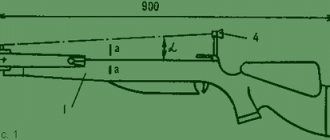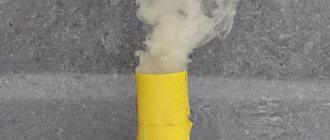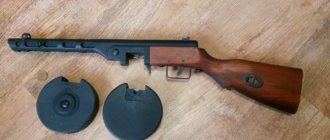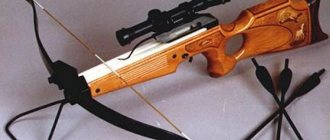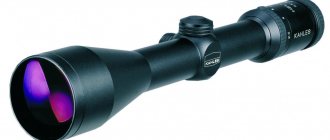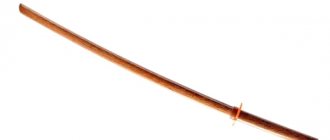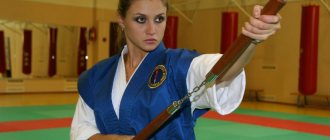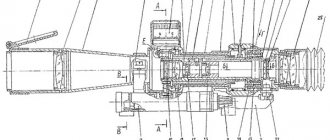Today, the use of a slingshot for hunting considered more exotic than commonplace. But at the same time powerful homemade slingshot occupies a certain place in the huge selection of weapons for hunting, located in the same row with bows and crossbows. Today on the Internet you can find a lot of information about how to make a homemade slingshot. You can also find a lot of tips to make your own rubber band for the slingshot.
What you need to create a slingshot
- 5 mm thick wire or wooden spear;
- suitable tires;
- genuine leather or a very durable leather substitute;
- insulating tape;
- nylon threads;
- good glue.
First you need to make the metal body of the slingshot. As mentioned above, it can be with or without a stop. Or you can simply cut a branch that fits the shape. If the body is made of wood, then you just need to peel off the bark, give it the required size, make slots for rubber at the ends of the horns and sand it. In the case when you will make a slingshot with your own hands from wire, you must first bend it, as shown in the figure, and insert a piece of hose into the forearm rest so that the surface does not cut into the hand. After this, you need to saw off a piece of wood, which will become the handle by which the shooter will hold his weapon. We split this workpiece in half, make slits in it where the wire will go, and then drill two holes for the bolts that will tightly tighten the steel body and both parts of the handle.
A simple option to make a slingshot with your own hands
- A strong slingshot will be no worse than one bought in a store, if you approach your homemade product responsibly. Find a branch that looks like the letter Y. It is advisable to use sizes that are between 15 and 20 cm long.
- To ensure the branch is strong and secure, make sure there are no cracks or chips before breaking it from the tree. It’s okay if there are small scratches on the branch; they can be easily cut off with a knife;
- The bark will become redundant, so it is often removed. This is done for aesthetic reasons.
- The best option would be a fresh branch. But the moisture it contains is excessive, otherwise the structure will lose reliability. How to dry it. The easiest way is to wrap it in material and dry it in the microwave. Use the correct step-by-step instructions:
- Wrap the future slingshot in a small towel. Place in the microwave and leave on the highest setting for a few seconds.
- The stick will create a hissing sound, when it stops, put it down again for a few seconds and do this several times.
The photo below shows what can happen if the stick is left for a long time without a towel. It may turn black or even catch fire. So be careful, watch what you do.
- Let's move on to creating notches. For this you will need a construction knife. Make cuts on the top of each branch, as shown in the photo.
- Let's move on to the choice of tires. In this example, a medical tube will be used; you, in turn, can use another rubber band, for example, a tourniquet, rubber from an old ball or a bicycle inner tube. The diameter is 80 mm, and as for the length, you decide what it should be. The traction force depends on this. The shorter the band, the stronger the throwing. Don’t forget that it still needs to be stretched, so you shouldn’t make it too short either. Once the length is chosen, cut the two tubes in half and tie the end of each to its own notch.
- Tie a piece of dental floss around the tube. The thread will tighten the tube and make it strong.
- Let's move on to creating the skin. It is not difficult to cut from any durable fabric, preferably leather. A 10x5 rectangle should have a small hole on each side (0.8 - 1.20 cm). Later we will thread the traction tube through these holes.
- Now everything is simple. Pass each end of the rubber tube through the holes. Make a knot on each one. Manipulation with dental floss can also be used in this case, the structure will become much stronger.
- The slingshot is ready. Practice using your new slingshot to shoot down any inanimate object, train your eyesight and accuracy.
This example is more suitable for the amateur method of throwing stones or other small equipment.
Powerful slingshot
This design is no longer so simple, but it is also within the capabilities of anyone.
Necessary materials and tools: metal wire with a cross-section of 5 mm in diameter and a length of about 70 cm, 2 medical catheters No. 22, a piece of leather, a stick, electrical tape, pliers and tweezers.
- Using pliers, you need to give the wire the correct shape. Bend it in half and form a stop, handle and horns.
- Then, if there is a soft rubber or dense foam cylinder, make a through hole in it in the center, thread it onto the wire and pull it to the stop. This is necessary so that the wire does not put pressure on your hand. You can also simply wrap it well with iso- or any other tape.
- Next, you need to cut the stick to the required length, trying it on your own hand. Make grooves on the sides of the stick for the wire.
- Insert the future handle into the workpiece and wrap it with electrical tape or secure it with other material.
- The ends of the horns also need to be insulated.
- Now you need to prepare a platform for the shells. You need to make two holes in the leather rectangle.
- Next, you need to cut off the tips of the catheters and make small holes in them along the edges, insert the catheter into the leather jacket. Through the hole made, using tweezers, insert the other end of the catheter into the hole and tighten. Do the same with the other thrust.
- The free ends of the catheter must be put on the slingshot, having previously moistened them with any alcohol.
The article selects the best options for how to make a slingshot at home. Use one of them, but don't forget that you can't shoot at people or animals! It’s better to make your own small shooting range, where the targets will be tin cans. Invite more friends and have fun together. At the same time, you can boast of a “personal weapon.”
There was a desire to do
an attribute of any hooligan from the times of the USSR, namely a slingshot.
My first thought, despite the fact that I like to do everything my own
hands
, was to just go and buy a slingshot.
But after weighing all the pros and cons of this idea, I decided that it would be more advisable to make it myself. So began sleepless nights and endless searches on blogs about how and what to make a craft
.
In fact, I learned from them that a standard slingshot consists of three parts: a skin, two rods, and a spear. In this article I will tell you how to make
a skin and attach rods to it. Let's get started)
Rods are 2 elastic bands due to which the projectile flies out of the slingshot. To make rods, you can use several types of elastic bands, we will talk about each of them now.
Probably the most famous and widespread is the tubular tourniquet.
The advantage of such a tourniquet is that it is easy to attach to the spear, but the disadvantage is that when stretched well enough, it returns very smoothly to its original position. I discarded it and decided to look further. It has also been discontinued and is quite difficult to obtain.
The second type of tourniquet is flat. Honestly, this is the worst rubber band I've ever seen. It stretches terribly and very smoothly returns to its original position, and besides, it is impossible to attach it to the skin.
You can use elastic bands for fitness; they have excellent stretch and return well to the reverse position.
In principle, the rods are ready, but for ease of fastening I recommend narrowing them a little at the edges. Now let's put it all together)
You need to fasten the rods so that the tail from the knot is on the outside of the skin and does not interfere with shooting.
The second part of the article will be published when it’s a sunny day and you can go planting and break out a good spear.
How to make a slingshot from wood and a powerful elastic band?
Manufacturers of homemade classic slingshots usually use natural wood to make them. But at the same time, the choice of species must be taken seriously, because the tree must have the following qualities:
- Elasticity.
- Hardness.
- Resistance to splitting.
Deciduous trees are considered suitable for this - rowan, walnut, maple, apple, acacia
When choosing a suitable branch for a homemade slingshot, pay attention to the presence of two symmetrically located and equal-thick branches, to which rubber bands will later be attached. After the selected branch is cut down, it needs to be cleared of bark and dried
photo. Rubber for a slingshot must be durable and elastic
The resulting “semi-finished” handle must be polished and adjusted to the dimensions and proportions that depend on your tastes and engineering preferences. But there are certain logical criteria: the handle should not be too thin and short, the horns should have the same height, the distance between them should not be too small or too large.
photo. Powerful slingshot made of wood
Previously, rubber medical bandages were most often used to make slingshots at home. Today, to make an elastic band for a slingshot, they began to use natural latex. Rods made from it will last quite a long time and have maximum contraction speed.
Improvements in shooting practice have made some changes to the design. Over time, it became clear that if the cords had different thicknesses along the entire length, the gun would shoot better.
photo. Homemade slingshot for hunting from a rope
Well-known manufacturers of sling rubber models for sports or hunting make their rods wedge-shaped or conical, and they taper towards the leather. The leather jacket should have medium hardness:
- A soft leather jacket is, of course, more comfortable to hold, but it can slip out unevenly, and this will affect the strength and accuracy of the shot.
- In hard conditions it is difficult to hold the projectile.
photo. How to shoot a homemade slingshot correctly
DIY slingshots for hunting, powerful slingshot made of wood
Army photos on Shutterstock: Army and military photos.
Making your own slingshot is very easy. At home, you can make not only a slingshot for a boy, but also a good slingshot for hunting. The most primitive slingshot that can be made at home is made from ordinary aluminum wire for making electrical wiring. The wire is bent and the insulation is cut off in a circle at the top. After this, a regular elastic band is attached and the ends are insulated again.
photo. DIY wooden slingshot
Making a wooden slingshot at home is very easy. To do this you will need a Y-shaped fork made of wood. The workpiece is cleared of bark and dried. After this, grooves are made for attaching the bowstring, on which the leather jacket is attached.
photo. Attaching an elastic band to a slingshot
photo. Attaching the skin to the cord with your own hands: diagram
Metal slingshot
Today, slingshots can even be made from metal. The manufacturing process for a metal slingshot completely coincides with the principle for making a wooden weapon.
All about slingshots: slingshot diagram, design and operating principle
A slingshot (in its classic form) is a small Y-shaped handle A “projectile” is placed in the central part of the slingshot, the rubber bands are stretched to the limit and released, the “projectile” flies out and a “shot” is fired. Such a tool can be easily made at home from any available materials.
Before you make a slingshot with your own hands, you need to familiarize yourself with its structure.
So, the simplest weapon in design - a slingshot - consists of several basic elements:
photo. Slingshot diagram
- Slingshot - It is used to secure rubber bands, as well as to hold the slingshot while aiming and firing.
- Bowstring (strings, cords) - Strips of rubber that are used to accumulate potential energy during tension and quickly return it to the “projectile” when fired.
- Saddle (kozhanka) - The central part of the slingshot, which is most often made of leather. Serves to capture and hold the “projectile”.
Shooting technique
How to properly use a slingshot for hunting and make the most successful shots that hit the target? Hunting with a slingshot can be a pleasure if you know the shooting technique.
The main thing in hunting with a slingshot is the aiming and stance of the hunter. That is, you need to understand the essence of how to shoot from a slingshot. First, let's look at the aiming technique. There are basically two techniques: instinctive and targeted.
Instinctive shooting
The essence of this method is that the hunter aims “by eye”. In this case, two eyes are focused on the target, the hunter sees the slingshot and skin only with peripheral vision. In this way, the goal is achieved more by intuition than by sight. If, according to the hunter’s feelings, the direction of the weapon and the rubber bands is correct, then the skin itself goes down. The advantage of this type of aiming is that the projectile range is automatically calculated. And when hunting, calculating flight range is a very necessary quality.
Another advantage is that it does not matter which eye sees better. The disadvantage of this type of aiming is that when changing the slingshot or the rubber band on it, you will have to re-master the aiming technique, because the trajectory of the projectile changes depending on the quality characteristics of this type of weapon
In order for shots to be accurate when intuitively aiming, you must be able to mentally imagine the trajectory of the ammunition. And this requires shooting experience, which can be gained by shooting at cans or targets. During the learning process, you need to constantly imagine which line the projectile will fly along, try not to blink during shots, and see the point where the projectile hits after the shot.
Aiming with an eye
When shooting with an eye, the results are more effective. The sight can be any landmark on the slingshot that aligns the eyes, the shooting device itself, and the target. You can make your own guide. The point of aiming will be that the aiming eye, the sight of the slingshot, will be lined up strictly in a straight line. For this type of aiming, it is better to use one eye, which has sharper vision. The second eye can be closed for convenience.
Most often, when using an eye gauge, the skin will be in a tense position in the area of the face on the side of the dominant eye. But we must not forget about convergence, which can significantly deteriorate the quality of shooting. Therefore, the slingshot sight must be placed at some distance so that the lines intersect at the location of the target. The scope is convenient to use when several models are used for hunting, with different tension forces and shot quality.
Depending on the hunter’s stance, and also depending on whether he is moving or standing still, several types of aiming and shooting can be distinguished:
Aiming technique while moving - keeping the sight steady while moving is a very difficult task, almost impossible. But this type of technique does not require the hunter to be completely immobilized. When moving, the sight should move along a line similar to a figure eight laid on its side, or along the line of the infinity sign. The point where the circles will intersect should be the target point. In fact, the point of aiming will be that the skin will be released when the line of sight coincides with the location of the target
It is important to act quickly here because how quickly the skin is released plays a big role. As you gain experience, your shots will be well-aimed and accurate.
The sight line can move along other trajectories. Some use horizontal or vertical movements of the sight.
Fixed aiming technique. With this technique, you need to aim the sight at the target, lock it and fire the shot. With experience, this technique gives very high results. To achieve high results in this technique, the main thing is to learn how to hold your hands with the weapon in a stationary position for as long as possible, and when shooting, make a minimum delay, up to about 6 seconds. This tactic is mainly used when shooting from a sports slingshot.
Ammunition and slingshot shooting
To shoot from a slingshot, you can use different objects, from stones under your feet to special “slingshot” projectiles.
- Rocks, rubble and other suitable objects are traditionally used for slingshot shooting. Due to their different sizes, shapes and weights, they fly along an unpredictable trajectory and are unsuitable over long distances;
- Glass balls allow you to track the trajectory of your flight, they are ideal in shape and weight, but flying fragments and high prices do not make them popular enough;
- Hunting buckshot is a cheap version of steel balls. Quite convenient projectiles, the disadvantage of which is their toxicity to the environment;
- Steel balls are ideal for use in slingshots. Their only drawback is their high price;
- Steel nuts can also be used as slingshot projectiles. Some hunters press lead into the middle of the nuts, making these projectiles deadly.
You can shoot from a slingshot at a distance of up to 25 meters, although this is not the limit. The main criterion for shooting accuracy is systematic training. There is a book that describes in detail the theory and practice of slingshot shooting (“Slingshot Shooting by Jack Koechler”).
You shouldn’t go hunting with a slingshot if you don’t have the necessary skills and you’re not confident in the power of your weapon, but sports or recreational shooting perfectly trains your eye and can bring a lot of joy.
Blitz tips
The skill of using a slingshot will appear after several fishing trips. The eyes and hands will begin to adapt themselves and understand at what angle they need to cast to the planned distances. You will only be able to vary your efforts when stretching the elastic band to increase flight accuracy.
The wind always becomes a hindrance:
- Lateral - the casting distance will, of course, remain the same, but the bait will scatter a little along the wiring line.
- Head-on - the distance will change when throwing, especially during gusty winds. We need to wait, wait for at least a little calm.
Slingshots of a new design will soon go on sale; it was invented by the British. The handle will serve as a place for tamping the feed. There the food will turn into a dense cylinder, and from there it should fly out over long distances.
The Shcherbakov brothers in the 60th issue recommend retracting the hand with the slingshot, and the cone with food is fixed at one point.
Correct shooting technique
This concept includes two components: aiming and the hunter's stance. By mastering both correctly, you can achieve amazing results. Experienced hunters are able to hit a target that is not standing still. And it’s also not uncommon to shoot while you’re on the move.
In this light, two aiming techniques are worth considering.
Instinctive shooting
This method is based more on imagination and feelings, although it does not abolish the laws of physics. Aiming is done with both eyes, and the slingshot is controlled by sensations, because it is completely outside of direct gaze. When the hunter feels that the direction of fire has been chosen correctly, by lowering his hand with the leatherette clamped in his fingers, the trajectory and flight range of the projectile is adjusted.
The undoubted advantage of this aiming method is that the shooter does not care which eye he sees better. But the disadvantages include two facts:
- If a hunter is poorly able to imagine the trajectory of a projectile, he is unlikely to achieve any success. This is the very imagination on which the method is based.
- The second is the fact that after replacing a worn out harness, you will have to spend some time shooting.
Mastering this method requires long training. But having mastered it, the hunter is unlikely to leave the forest without trophies.
Aiming with an eye
Installing a landmark on a slingshot for hunting can significantly increase the efficiency and accuracy of shooting even for an inexperienced shooter. But there are some nuances here:
- You will have to aim with one eye, the one that is sharper.
- The reference point should be set slightly to the side, since the hand with the skin will be in close proximity to the face, and this fact can negatively affect accuracy.
- When choosing a reference overlay, you need to ensure that it matches your individual color sensibilities.
The essence of aiming with an eye comes down to the following: three points must be lined up on one line. Eye, sight and target. The flight range is determined in the same way as in the previous method.
A well-made and individually adjusted eye can easily be used with several types of slingshots, simply by moving it from one to another, which can significantly improve hunting results.
Hunter Stance
When hunting with a slingshot, sometimes there is no time left to take the correct stance. Find support for your feet, fall on one knee, or vice versa, straighten up. All these movements in the forest, where any movement means danger for the animal, can scare away the prey, and you will have to spend some more time searching for it. Therefore, the hunter’s stance comes down to two concepts, from which the method of aiming follows.
- In move. Experienced shooters advise not to try to keep the sight exactly on the target while moving. It is almost impossible to do this, and by and large it is not required. The sight can move along a certain trajectory, the ideal example of which would be the infinity sign - an eight falling on its side. The junction of the imaginary lines will be the aiming point. As soon as the shooter feels that the movements have converged at this point, and it, in turn, coincides with the target, a shot is fired. "Infinity" is not the only option. The trajectory of the sight should be selected individually.
- Fixed aiming. At first glance, nothing complicated. Point the sight at the target, make sure that all three points coincide and release the skin. But there are subtleties here too. Learning to hold a tense slingshot straight throughout the entire time of sight is not easy. And one more thing: between the moment when the sight found the target and the shot, the delay should be 5, maximum 7 seconds. In the forest when hunting, this method is rarely used, since you can’t sit in an ambush with a slingshot, so this method of aiming is more suitable for sports competitions and shooting.
In general, there are nuances. However, having mastered all these skills, you can safely take the slingshot into service.
Design and principle of operation
The device of a simple slingshot is quite simple and consists of several parts:
- The “flyer” itself or the frame on which all other elements of the slingshot are attached;
- Rubber bands or “strings” that serve as a string for a slingshot;
- A casing or saddle into which a throwing projectile is inserted.
A homemade slingshot (classic) is a simple wooden handle, forked at the end, like the horns of an animal. A tourniquet is attached to these “horns,” which sends the projectile to the target. The projectile is inserted into a skin made of durable leather. Slingshots can be used for various purposes, depending on their design and the use of various materials during their assembly.
Types of slingshots:
- A lightweight slingshot is mainly used for recreational shooting or mastering shooting skills. These are basically small slingshots of a classical design;
- The medium slingshot is a more advanced model and can be used for sport shooting. A slingshot for hunting from this group is unlikely to work, since the average slingshot does not have the necessary power reserve for this;
- A large slingshot (also called a fighting slingshot) can be used for hunting small game. It may look like your average slingshot, but the quality of the materials used to create it is noticeably higher.
In addition to dividing by size, slingshots are also divided by purpose:
- The hunting slingshot is an expensive factory model. To use it you need sufficient experience in using slingshots. If handled carelessly, this model can cause significant injury. Although the average slingshot is also dangerous, a cool slingshot for hunting is already a weapon (although not legally subject to this definition);
- A sports slingshot is a fairly expensive and powerful model. Shooting from a slingshot intended for sport is a very exciting activity that develops the eye. For professional sports shooting, both a medium and large slingshot can be used.
How to make a slingshot for hunting
Regardless of the material and manufacturing method, the approximate width between the “horns” should be from 4 to 7 cm, the length of the handle and horns are selected individually, they are not too important for successful shooting, they have a greater influence on the convenience of the shooter
. Therefore, try to imagine what will be more convenient for you, and choose the length and width of the slingshot according to these parameters. But remember that a slingshot cannot be too thin for hunting; it must withstand frequent shooting with heavy projectiles. The horns should be positioned at the same angle to the handle and be as uniform in thickness as possible.
Wooden slingshot. It is best to use walnut, oak, maple or ash. You will need either a naturally forked branch or a piece of board if you want to carve the slingshot yourself. Using a jigsaw, we cut out the slingshot into the desired shape; it is better not to make it flat - a flat slingshot does not lie very comfortably in the hand. If you manage to find a suitable branch, clear it of bark. We sand the workpiece with sandpaper manually or using a grinder.
We are preparing the place for attaching the elastic band. You can attach it in several ways.
We make slits corresponding to the width of the elastic band, at a distance of 1.5 - 2 cm from the ends of the horns. We wrap an elastic band around the horns and tie a knot.
We make slits as described above, place the ends of the elastic band on the horns so that they are not perpendicular to them, as in the 1st point, but serve as a continuation of the horns, and tie them at the slot with a thin elastic band.
We drill holes at the same distance from the ends of the slingshot corresponding to the diameter of the elastic band, thread it through them and tie knots so that the elastic band cannot jump out.
Slingshot made of epoxy glue. Knead "Poxypol" or any other two-component epoxy glue, and mold it into a slingshot of the desired shape. When sculpting a handle, take the epoxy mass in your palm and squeeze it a little, but not too much, as if not squeezing. If you squeeze too tightly, the slingshot will be awkward to hold in your hand when shooting.
After hardening, we follow the papier-mâché principle - we glue the slingshot with 5 - 6 layers of paper using PVA glue. You need to tear the paper by hand; it is better to alternate plain paper and newspaper in layers - this way you will see whether the entire surface has been glued with a new layer. After the last layer has dried, drill holes for the elastic at a distance of 1.5 - 2 cm from the top edge of each horn. You can slightly widen the hole on one side so that the knot does not stick out, but “sits” in the recess.
We sand the product with sandpaper, and then prime it with PVA
, mixed with chalk, or water dispersion. Sand again with fine-grain sandpaper and paint.
This slingshot looks very aesthetically pleasing and is in no way inferior in quality to a traditional wooden one.
The holes and slots for the rubber bands in any version of the slingshot must be sanded as best as possible, otherwise the rubber band will quickly wear out.
The slingshot saddle (the part in which the projectile is placed) is best made from a piece of thick leather 3 cm wide and 5 cm long. We make small holes along the edges, thread an elastic band through them, and tie a knot.
The choice of elastic band is perhaps most important for the killing power of a slingshot.
. The best indicator of elongation is 80% of the length in a “quiet” state. The fastest contracting, and therefore the most powerful, will be flat latex. The manufacturer most loved by slingshots is Thera band, but you can purchase other types of rubber if you can’t find it. You can buy this latex in sports stores; it is used by athletes for training. From it you will need to cut a strip 1.5 to 2 cm wide.
You can also use a round rubber band - for example, a latex catheter purchased at a pharmacy. You can also buy a special rubber band for slingshots, but as a rule, it is not very easy to find.
The length of the elastic is determined individually
— it depends on the length of the shooter’s arm and on how well the rubber stretches. To choose the optimal length, you need to try to “shoot” the slingshot with different elastic lengths.
An original slingshot for homemade work with children
It's no secret that most children who like slingshots are boys. Therefore, you can use this master class as a development activity for your son or grandson. To start the process you will need the following tools:
- Toilet paper tube. You'll have to prepare in advance; you won't unwind a whole skein;
- Insulating tape;
- Pencil;
- Rubber;
- Scissors.
- Take a cylindrical shape of toilet paper and cut it vertically, this will make it easier to roll. Roll it into a stick and wrap it with electrical tape.
- At the end of the cardboard stick, make a hole the diameter of a simple pencil. Insert it, turning it round and round.
- Let's move on to the skin. To make it you will need durable cardboard. Using scissors, cut out a rectangular shape and use a hole punch to make holes for the elastic along the edges.
- You determine the length of the elastic yourself; if you don’t stretch it on one side only, it is approximately equal to the length of a pencil. Insert it into the holes of the leatherette, tying each end into a knot. And twist the other end onto the end of a pencil and tie tightly. This way you will get a slingshot that you can play with at home, and you can come up with anything you want in the form of bullets. For example, soaked paper from which you form bullets with your fingers.
Slingshots made of cardboard will be stronger when the handle, which bears the main force, is strong. Therefore, it is better to additionally wrap it with adhesive tape.
Rules for using a slingshot: caution
Some types of slingshots are considered melee weapons, but even if the slingshot you buy is legal to use everywhere, this does not open up the boundaries for you to shoot animals and people. Do not hold the slingshot at eye level and do not aim at the eyes of the person standing next to you; even a small bullet can lead to dire consequences.
Homemade slingshot from board or plywood
You can also take a more complicated route - using a jigsaw to cut out a base for a slingshot from a board or plywood.
Sharp corners will have to be rounded off with sandpaper or sandpaper, or something should be wrapped around the handle. Most likely, every home has duct tape. This would make a great slingshot, considering that electrical tape comes in a variety of colors. You can also use soft leather or other material that needs to be easily secured so that it will not slide along the handle. A great idea would be to put a name or some kind of symbol on the handle or horns. It used to be fashionable to burn various patterns on wooden products using a wood soldering iron. In the case of a slingshot, it can also come in handy.
Slingshot device
No man needs to explain what a slingshot looks like. A homemade slingshot, made from scrap materials, has been in the hands of almost every boy. But it still doesn’t hurt to remember. Moreover, modern hunting slingshots have undergone some improvements, and manufacturers no longer use forked branches specially spotted on a particular tree. Although the principle remained unchanged.
So, a slingshot for hunting consists of three main parts:
- The base, which simultaneously serves as a handle and a place for attaching the harness.
- Tourniquet. Power and range depend on its elasticity and resilience.
- Kozhetok. A specially selected piece of tanned leather into which the projectile is inserted.
Previously, the process of making a slingshot began with finding a suitable branch. The type of wood also mattered. Oak, ash, cherry or apple trees were best suited for this purpose. A dense forked branch was tied with twine and left for a while so that it took the desired shape. Only after this the blank for the slingshot was cut off. They removed the bark from it, polished it and burned it.
A multi-layer elastic cord was attached to the upper ends, in the middle of which a leatherette was attached - a small piece of tanned leather. Then the slingshot had to be shot, because it is impossible to make products identical in strength, range, accuracy and lethality.
Modern models use other materials. More durable and flexible.
Shooting principle
A projectile is placed in the skin. The tourniquet is stretched too much. The distance of the target in this case does not play a role. The projectile must receive the maximum charge of kinetic energy. Not only the power, but also the accuracy of the shot depends on this. Aiming is in progress. Then the skin is sharply released, the tourniquet instantly contracts and sends a projectile. In this case, the speed can reach 70-90 m/s, and the range is 200-250 meters. These indicators do not apply to all types of slingshots. Everything will depend on the material from which it is made, the design features and the type of projectile.
Ammunition
There's not too much variety here. But after many years and even centuries of practical exercises, three types of projectiles for hunting slingshots were chosen:
- Plastic balls of various weights and sizes. They are not very effective for hunting, or more precisely, they are too light, but they are ideal for training.
- Metal buckshot and shot. These are just combat options.
- And, of course, small-sized and suitable-shaped pebbles. This type of shell can be easily found right on the spot.
Advantages and disadvantages
The debate on this topic will never subside. Some consider a slingshot to be an ideal weapon for hunting. Others, on the contrary, do not compare it with the same bow or hunting crossbow. And there’s nothing to say about a good branded gun or carbine. However, not all so simple.
The undeniable advantages of the slingshot:
- Can be used under any circumstances. Even if you went into the forest to pick mushrooms or go fishing in the river, you can make a targeted shot at any time.
- Having certain skills, preparing for a shot takes only a few seconds. Which, coupled with noiselessness, makes it possible for a second attempt to hit the target if the first was unsuccessful.
- The slingshot is easy to carry and even with a supply of shells it is quite light.
- Relatively high power. There are slingshots whose destructive power reaches 70 meters or more. Of course, it can’t be compared with a gun, but in a dense forest sometimes there are only ten meters left.
- Silence.
- And the last argument is cheapness.
What other arguments could there be that speak in favor of a hunting slingshot? They certainly exist, as well as disadvantages:
- To learn how to properly and successfully use a slingshot for hunting, you will need many days of training.
- Large game is not available for this type of weapon, although cases of wild boars have been reported.
- No matter how high-quality the harness is, its service life is very limited.
- Not a long aiming range. This point was also noted in the merits, so it all depends on the circumstances in which the slingshot is used.
Having considered both lists and having considered what outweighs the advantages or disadvantages, you will have to make a choice: will you take the slingshot into service and go hunting for hares, squirrels and other small game. Or will you prefer a more lethal weapon, which will provide the opportunity to kill a larger animal.
Pocket Weapon: Where to Use a Slingshot
The first thing that comes to mind for a person who is not interested in this type of weapon is the boys playing in the yard. But the slingshot has a much broader horizon and its properties very often become useful at home. Let's figure out where you can use a pocket weapon.
- Anyone who has a vegetable garden or garden knows that very often it is attacked by petty thieves such as crows and other types of birds. You can save yourself with a scarecrow, but if it doesn’t help, you can drive away the ill-wishers with a slingshot. Just be extremely careful so that if you miss, there is no other person far away from you.
- “The pear is hanging - you can’t eat it” - this is how the well-known riddle begins, but today is not about it. The slingshot can be used to aim to hit the fruits that are located at the very top of the fruit tree.
- The tourist needs to give the slingshot its due. A foreign country is full of unexpected surprises, unless, of course, you are aware in advance of some of its dangerous zones. In this case, a slingshot can be useful in scaring away wild animals and protecting yourself from dogs. If you decide to stay overnight in the forest for a few more days, then this is the perfect time to try your weapon on small animals. Such hunting does not require licenses or special permits.
- Anglers often use a slingshot to throw food into the distance of a reservoir.
- With the help of a slingshot they develop accuracy. Using it for such purposes, in a very short period of time, you will shoot down targets from a very long distance.
As you can see, a slingshot is a very useful throwing device that is accessible to every person. You can put it in your pocket and carry it with you as a protective device.
